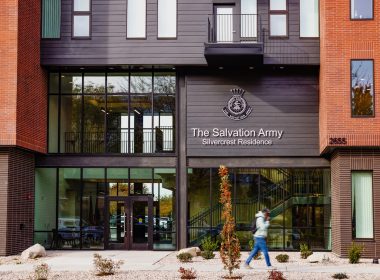It’s open to men, women and children, with safe sleep arrangements in place.
By Vivian Lopez –
As temperatures dropped and cold weather conditions became a frigid reality, The Salvation Army in Santa Cruz, California, under contract with the county, opened its winter shelter doors.
The facility will serve the area’s growing homeless population through April. The latest Santa Cruz County Homeless Census and Survey reported that 2,249 people were facing homelessness in the county during the 2017 Santa Cruz County Point-in-Time count, a nearly 15 percent increase from 2015.
Captain Harold Laubach, Salvation Army Santa Cruz County Coordinator, said high living costs, limited land space for affordable housing and substance abuse rates in the area contribute to the increasing homelessness rate.
“It makes for the perfect storm for homelessness,” Laubach said. “One little problem, whether it be losing your job, getting sick or having a car accident, and you miss a paycheck and all of a sudden you’re out on the street.”
Notably, cuts to federal and state funding for emergency shelters had left Santa Cruz in a bind.
“The funding stream shifted…to a housing-first model and the funding dried up for emergency shelters,” said Debbie Bates, winter shelter program director.
As a short-term solution, Laubach said Santa Cruz County officials decided to fund a winter shelter program and work with local organizations to run it.

Last year, The Salvation Army in Santa Cruz worked with other community agencies as a group, supplying its corps building for emergency winter shelter efforts. However, this year the county approached The Salvation Army directly to run the shelter program.
“We want the homeless to feel [they are] part of the community at large and not so isolated, segregated or marginalized,” Bates said. “This is not a situation that is going to just disappear.”
Shelter capacity is approximately 100 people, and is split between two buildings: The Salvation Army and the local Veterans of Foreign Wars (VFW). It’s open to men, women and children, with safe sleep arrangements in place.
There is also a bus available with handicap access and bicycle racks that makes stops around town to pick up clients with mobility issues and bring them to the shelter.
Additionally, Laubach said The Salvation Army has partnerships in place to connect its winter shelter clients to more services and resources in hopes of helping them transition out of homelessness, including physical and mental health services and job and housing placement guidance. One partnership with local organization Homeless Person’s Health Project even brings nurses to the shelter to give clients vaccinations they may need.
“We don’t want to just simply give them a place to stay so a year from now they’re right back here in the same spot,” Laubach said. “I would like our program to be successful in that it continues to show people transitioning out of homelessness and back into [positive] lifestyles and being productive members of the community.”
Laubach said it’s an emotional thing to see people coming in and out of the shelter every day, and the local government and community working together for the common good.
“I see this as an answered prayer, especially to our area,” Laubach said. “It is inspiring and awesome to see God work in a way that the finances, community and the Army are taken care of all at the same time. It is really nice to see everyone come together to treat each other like we’re called to be treated.”









